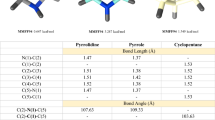Abstract
Thirty three chalcones were synthesized and tested on viral H1N1 neuraminidase activity by using MUNANA assay [2′-(4-methylumbelliferyl)-α-d-N-acetylneuraminic acid] assay with DANA (2,3-didehydro-2-deoxy-N-acetylneuraminic acid) was used as standard. 2D and 3D-quantitative structure−activity relationship models have been successfully developed with a good correlative and predictive ability for quantitative structure−activity relationships of these chalcone derivatives. Result from the 2D-quantitative structure−activity relationship model indicates that electrostatic parameter enhanced bioactivity of the chalcones while steric substituents diminished their potency as H1N1 neuraminidase inhibitors. 3D-quantitative structure−activity relationship model showed the importance of the position of the hydroxyl group in chalcone derivatives which can influence on hydrophobicity, hydrogen bond donor and aromatic ring features that enhance the biological activity. Finally, docking studies showed that chalcones MC8 and MC16 with low C docker interaction energies and higher numbers of hydrogen bonding have better inhibitory activity against viral H1N1 neuraminidase.






Similar content being viewed by others
Reference
Babu YS, Chand P, Bantia S, Kotian P, Dehghani A, El- Kattan Y, Lin TS, Hutchison TL, Elliott AJ, Parker CD, Ananth SL, Horn LL, Laver GW, Montgomery JA (2000) BCX-1812 (RWJ-270201): discovery of a novel, highly potent, orally active, and selective influenza neuraminidaseinhibitor through structure-based drugdesign. J Med Chem 43:3482–3486
Frimayanti N, Lee VS, Zain SM, Wahab HA, Rahman NS (2013) QSAR and pharmacophore studies on thiazolidine-4-carboxilic acid derivatives as neuraminidase inhibitors in H3N2 influenza virus. Med Chem Res 23(3):1447–1453
Gao L, Zu M, Wu S, Liu AL, Du GH (2011) 3D QSAR and docking study of flavone derivatives as potent inhibitors of influenza H1N1 virus neuraminidase. Bioorg Med Chem Lett 21:5964–70
Jeong HJ, Ryu YB, Park SJ, Kim JH, Kwon HJ, Park KH, Rho MC, Lee WS (2009) Neuraminidase inhibitory activities of flavonols isolated from Rhodiolarosea roots and their in vitro anti-influenza viral activities. Bioorg Med Chem 17:6816–6823
Mahto MK, Raj VK, Bhaskar PM, Divya R (2012) ADMET and molecular docking studies of novel zanamivir analogs as neuraminidase inhibitors. Int J Pharm Sci Rev Res 13(1):91–94
Medina-Franco JL, Golbraikh A, Oloff S, Castillo R (2005) Quantitative structure activity relationship analysis of pyridinone HIV-1 reverse transcriptase inhibitors using the k nearest neighbor method and QSAR-based database mining. J Comput Aided Mol Des 19:229–242
Marais JP, Ferreira D, Slade D (2005) Stereoselective synthesis of monomeric flavonoids. Phytochem 66:2095–2176
Mercader AG, Pomilio AB (2010) QSAR study of flavonoids and biflavonoids as influenza H1N1 virus neuraminidase inhibitors. Eur J Med 45:1724–1730
Potier M, Mameli L, Belisle M, Dallaire L, Melancon SB (1979) Fluorometric assay of neuraminidase with a sodium (4-methylumbelliferyl-α-Image -N-acetylneuraminate) substrate. Anal Biochem 94:287–296
Praphat K, Preety S, Singh JS (2011) Topological based QSAR study of benzamine as inhibitor of trombin. J Chem Pharm Res 3(4):396–303
Ryu YB, Curtis-Long MJ, Kim JH, Jeong SH, Yang MS, Lee KW, Le WS, Park KH (2008) Pterocarpans and flavanones from Sophoraflavescens displaying potent neuraminidase inhibition. Bioorg Med Chem Lett 18:6046–6049
Ryu YB, Curtis-Long MJ, Lee JW, Ryu HW, Kim JY, Lee WS, Park KH (2009) Structural characteristics of flavanones and flavones from Cudraniatricuspidata for neuraminidase inhibition. Bioorg Med Chem Lett 19:4912–4915
Ryu YB, Kim JH, Park SJ, Chang JS, Rho MC, Bae KH et al. (2010) Inhibition of neuraminidase activity by polyphenol compounds isolated from the roots of Glycyrrhiza uralensis. Bioorg Med Chem Lett 20:971–974
Sharma MC, Kohli D (2014) Insight into the structural requirement of substituted quinazolinone biphenyl acylsulfonamides derivatives as Angiotensin II AT1 receptor antagonist: 2D and 3D QSAR approach. J Saudi Chem Soc 18(1):35–45
Wermuth CG (1998) Glossary of term used in medicinal chemistry. Pure Appl Chem 70:1129–1143
Acknowledgments
We thank University of Malaya for the financial support through the project Grant Scheme 53-02-03-1059 and Malaysian Ministry of Science, Technology and Innovation for the H1N1 grant 09-05-IFN-MEB 004.
Author information
Authors and Affiliations
Corresponding author
Ethics declarations
Conflict of interest
The authors declare that they have no conflict of interest.
Electronic supplementary material
Rights and permissions
About this article
Cite this article
Yaeghoobi, M., Frimayanti, N., Chee, C.F. et al. QSAR, in silico docking and in vitro evaluation of chalcone derivatives as potential inhibitors for H1N1 virus neuraminidase. Med Chem Res 25, 2133–2142 (2016). https://doi.org/10.1007/s00044-016-1636-5
Received:
Accepted:
Published:
Issue Date:
DOI: https://doi.org/10.1007/s00044-016-1636-5




